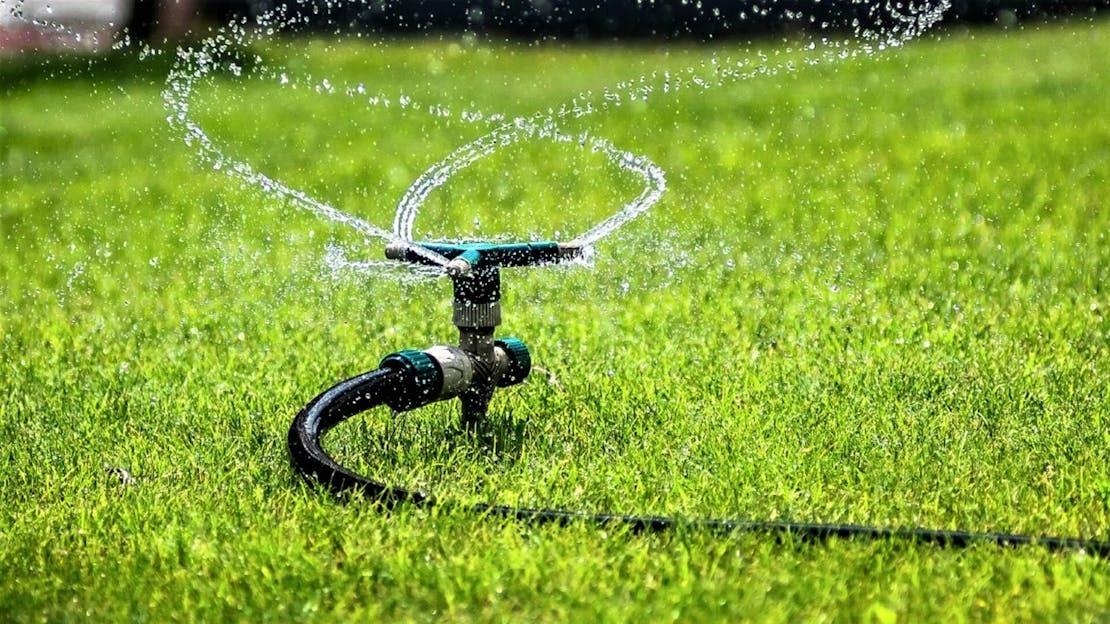
Watering the Lawn
Most people irrigate grass and turf incorrectly, which creates shallow roots and lots of weeds, so do it right or don’t do it at all!
Watering the lawn is normally by choice not necessity. Grass unlike most other plants goes into a state of dormancy when moisture reaches critical levels. It will resume growth once water becomes available again.
There are some sound reasons for not watering the grass. For reasons of conservation when reservoirs are not being adequately replenished, when cost is an issue or when watering may do more harm than good.
On the other hand there are good reasons to water the lawn particularly if you need to keep a good surface for games or kids or if you’ve undertaken some form of renovation and need to promote recovery. Other times you may just need a light watering to soak moss prior to applying a ferrous sulphate based moss killer or as part of seeding or turfing process. For the heavier watering to maintain grass cover, after renovation or just to keep it looking green the following guidance will help.
How Often
Water when the lawn tells you to, not according to some arbitrary plan. Your soil type, grass type, exposure to sun and wind are just a few of the factors that will determine how frequently you need to water. It also goes without saying that an adequately fertilised lawn will tolerate dry conditions better than one lacking proper nutrient levels. This might mean some lawns require watering once a week whilst others only need water once a month in exactly the same weather conditions.
The signs to look for when the lawn is starting to gasp a little are: a change in colour with the lawn becoming dull as moisture levels become low. In addition the lawn will lose its ‘springiness’ and foot prints will remain in the lawn when normally the grass would spring back to shape.
If the lawn has started to turn brown however, you’re well passed the watering point and it may be best to let the lawn go dormant!
Testing for Moisture
A crude indicator of moisture in the lawn would be how easy is it to push in a 6" screw driver. Water a small area (a square metre) slowly and gently over a few hours so that it is as wet as it is ever likely to be. The screw driver should now go in a long way very easily. Now probe the rest of the lawn; half the screw driver indicates good moisture but only an inch or two with resistance indicates drying soil and in need of more rain or water prior to feeding or seeding.
The other way is to use a bulb planter or the corner or a spade and open up a little bit of lawn to a depth of about 3". Is it dark with moisture or dry and crumbly?
How much Water
Water deeply each time you water – at least half an inch for clay soils and an inch (25mm) for sandy soils. You can work this out by placing a few straight sided containers (empty paint tins are ideal) in the sprinkler area to catch some water. If you time the process until there is the required amount of water in the container you’ll know how long to water for.
But I’m on a Water Meter!
As of 2020 a cubic metre of water costs £3. If you were to water at 25mm per square metre (an inch deep) on a 100m2 lawn this would be 2.5 cubic metres of water or £7.50. Doing this weekly during the driest one or two months is affordable for many and may cost less than repairing the lawn.
When to Water
You must avoid having wet grass at night as this promotes disease. Therefore, water before the heat of the day so that the lawn has time to dry before nightfall. You can put the sprinkler on anytime from 4am to early afternoon on most days even sunny ones. If the temperature gets above 240C/750F turn the water off.
If you have disease in the lawn watering can make it worse. Red Thread and Fusarium will get worse in wetter conditions whilst watering will help the grass fight off Rust diseases. See Pests & Diseases for more detail.
Watering in a Heatwave
Extreme heat can stress the lawn so under super hot conditions be prepared to give your lawn a cooling shower for about 10 minutes. You can do this in the hottest part of the day and it will bring the soil temperature down considerably. It's not likely to add much in the way of watering but it will enable the grass plants to access some water more easily and cool themselves down by transpiration; the equivalent of sweating.
Consequences of Incorrect Watering
Watering too often, too little or at the wrong time of day promotes disease, moss, weeds, weed grasses such as annual meadow grass and shallow rooting. Better no watering than watering incorrectly! Pop up automatic sprinkler system watering daily can be the cause of many lawn problems.
Water Repellent Soil
Sometimes soil becomes very hard to re-wet once it has dried out. Even though this might be due to a fungal condition such as dry patch using a wetting agent can aid water penetration and retention in most circumstances.